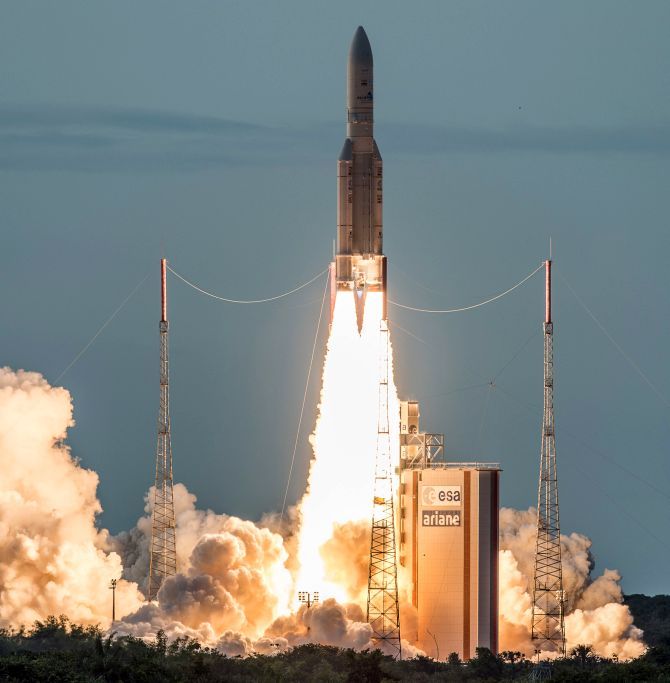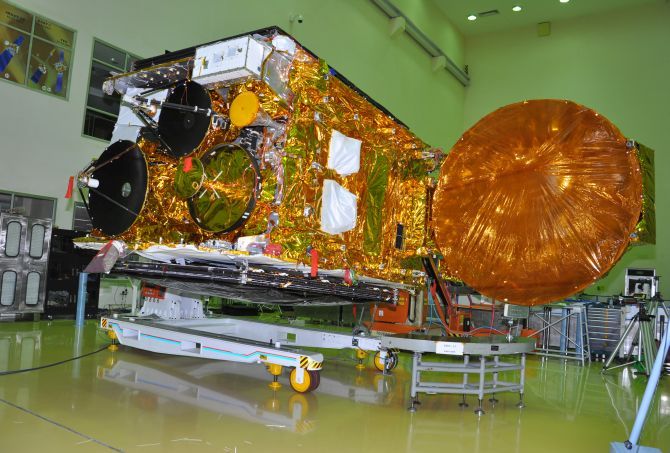India's latest communication satellite GSAT-17 was on Thursday successfully launched by a heavy duty rocket of Arianespace from the spaceport of Kourou in French Guiana.

Configured around I-3K extended bus, GSAT-17 with a lift-off mass of about 3,477 kg carries payloads in Normal C-band, Extended C-band and S-band to provide various communication services.
It also carries equipment for meteorological data relay and satellite based search and rescue services being provided by earlier INSAT satellites.
The European launcher Arianespace Flight VA238 blasted off from Ariane Launch Complex No 3 (ELA 3) at Kourou, a French territory located in northeastern coast of South America at 2:45 am IST, couple of minutes delayed than the scheduled time of 2:29 am.
GSAT-17 was injected shortly after orbiting co-passenger Hellas Sat 3-Inmarsat S EAN in a flawless flight lasting about 39 minutes.
"GSAT-17 successfully launched by Ariane-5 VA-238 from Kourou, French Guiana," the ISRO announced after the mission.
ISRO's Master Control Facility at Hassan in Karnataka took over the command and control of GSAT-17 immediately after its separation from the launch vehicle, and the preliminary health checks of the satellite revealed its normal functioning.
GSAT-17 that will strengthen ISRO’s current fleet of 17 telecommunications satellites was launched into a Geosynchronous Transfer Orbit.
This was the third satellite launch mission by the ISRO this month, the other two being first developmental flight of GSLV MkIII and PSLV C-38 missions -both from Sriharikota spaceport.
GSLV MkIII successfully launched GSAT-19 satellite on June 5 while PSLV-C38 orbited Cartosat-2 Series satellite along with 30 co-passenger satellites on June 23 from the Satish Dhawan Space Centre.
GSAT-17 is also ISRO's third communication satellite to successfully reach orbit in the past two months.
The ISRO, which has been dependent on Ariane-5 rocket for carrying its heavier satellites, is developing GSLV Mk III for this purpose.
Announcing the successful launch of the satellite, Arianespace CEO Stephane Israel tweeted: "Confirmed: GSAT-17 has successfully separated from its #Ariane5 launcher #VA238 @ISRO."
Thanking Arianespace, Director, Vikram Sarabhai Space Centre Dr K Sivan, who watched the launch from the mission control centre called it a "text book mission".

Noting it as a special mission for ISRO, he said "GSAT-17 is a need of the hour for ISRO and India as it provides the continuity in services of ageing two satellites, as well as augmenting our transponder capability, and widening our horizon to mobile satellite services as well as to Antarctica areas."
GSAT-17 was the 21st satellite from ISRO to be launched by Arianespace, and its designed in-orbit operational life is about 15 years.
In the coming days, orbit raising manoeuvres will be performed to place GSAT-17 satellite in the Geostationary Orbit (36,000 km above the equator) by using the satellite’s propulsion system in steps, the space agency has said.
During the final stages of its orbit raising operations, the two solar arrays and both the antenna reflectors of GSAT- 17 will be deployed and following this, the satellite will be put in its final orbital configuration.
It said GSAT-17 will be positioned at its designated orbital slot in the geostationary orbit and will be co-located with some of the Indian operational geostationary satellites, and later it is planned to turn on the communication payloads of the satellite.
After the successful completion of all the in-orbit tests, GSAT-17 will be ready for operational use.
GSAT-17’s co-passenger Hellas Sat 3-Inmarsat S EAN is a two-payload "condosat" produced by Thales Alenia Space for Hellas Sat and Inmarsat.
Once in orbit, the Hellas Sat 3 component will deliver direct-to-home and telecom services to maintain and expand Hellas Sat’s business reach, while the Inmarsat S EAN component provides the satellite portion of Inmarsat’s new European Aviation Network.
Hellas Sat (member of the Arabsat Group) is a premium satellite operator, offering services in Europe, the Middle East and South Africa from the orbital position of 39 East.
Inmarsat is the leading provider of global mobile satellite communications services. The total payload carried on Flight VA238 is approximately 10,177 kg.










